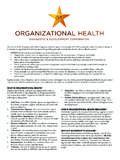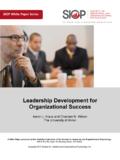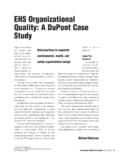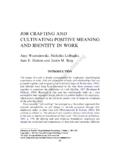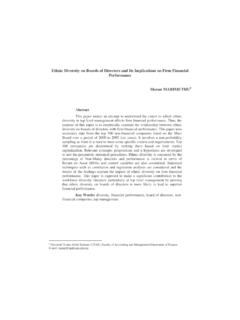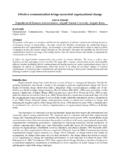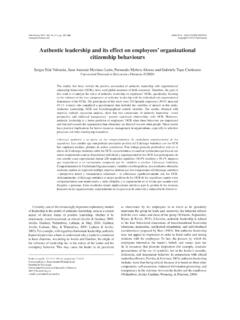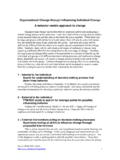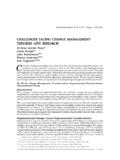Transcription of Organizational Health
1 Using an assessment tool to diagnose internal conditions and relationships before writing a prescriptionThe School Administrator - May 2003 Organizational HealthBy Gerald D. HillWhen I was hired seven years ago as superintendent of a suburban Chicago school district, the board made it abundantly clear that one of my top priorities was to improve implementation of the district s strategic plan. My charge was to get Community Consoli-dated School District 146 to the next level. I spent the first several months reading everything I could find about the district and its strategic plan, Education 2000. I talked to teachers, principals, parents and community members in this 2,500-student pre-K through 8th-grade district. I witnessed pockets of innovation and random acts of implementation, but no overall commitment to the mission and vision spelled out in Education 2000.
2 The strategic plan was not central to the thinking of the district s school leaders nor was it a part of the teachers instructional short, the district was ailing, and the healing had to begin at its very HealthI had faced a similar situation in a 40,000-student, suburban Dallas school district several years earlier. Rapid growth and dramatic de-mographic changes caused the district to lose focus. We responded by implementing an Organizational Health diagnostic and develop-ment process that focused our efforts on improving the school climate and creating an optimum learning environment for determined the only way my district would rise to the next level was to focus, as we did in Texas, on assessing, prescribing and then improving the district s Organizational Health is an organization s ability to function effectively, to cope adequately, to change appropriately and to grow from within, according to Marvin Fairman, president of Organizational Health : Diagnostic and Development Corp.
3 Because an organiza-tion consists of many different subsystems, he says, the Health of each subsystem affects the organization s overall needed to know what parts of our school district were not performing optimally. In the spring of my first year as superintendent, I introduced the Organizational Health assessment improvement Health CycleAfter ensuring support from the district office and the schools, we began the cycle of diagnosis and prescription. Each school and cen-tral administrative department participated in the process, which began with orientation sessions for administrators and teacher leaders at each school and within each district department. These sessions, held during the school day in February and March, introduced Organizational Health concepts, key leadership beliefs and the improvement certified staff completed the Organizational Health instrument, which assesses an organization s internal workings.
4 The 80-question survey measures the Health of an organization s subsystems, including the following 10 dimensions. Schools and departments usually can be found at various stages of development within each area. Goal focus the ability to have clarity, acceptance, and support for goals and objectives; Communication adequacy the extent of open two-way communication; Power equalization the ability to maintain a relatively equitable distribution of influence between team members and their leader; Resource utilization the degree to which the leader knows and is able to coordinate the talents of team members with minimal stress; Cohesiveness the clarity of a person, group or organization s sense of identity; Morale the feeling of well-being, satisfaction and pleasure; Innovativeness the ability to be and to allow others to be inventive, diverse, creative and risk-taking.
5 Autonomy a person, group or organization s freedom to manage those things they believe should be within their sphere of influ-ence; Adaptation the ability to tolerate stress and maintain stability while coping with external demands; and Problem-solving adequacy the ability to perceive problems and to solve them with minimal survey responses were based on their perceptions of their school. Principals responded by predicting how they thought the teachers would respond. Leaders scores were compared to staff scores and the results were expressed in a percentile score for each of the 10 dimensions. This gave the principal feedback regarding his or her knowledge of staff perceptions about key functions of the school as well as reliable data about the school s overall on the responses, raw scores were established for each of the dimensions.
6 After the principal and administrators reviewed the data and the overall organization profile, an Organizational Health consultant/coach and I met with the principal to discuss the data and what it indicated about the Health of the for HealthThe principal and Organizational Health consultant/coach shared the results with school staff and discussed their implications. The data-sharing sessions actually became training sessions. Staff members became familiar with the 10 dimensions of Organizational Health and how each dimension affected how they worked together to achieve their school s goals. They were encouraged to look at issues from a leader s perspective, from their colleague s perspectives and from an Organizational multi-perspective approach conveyed a shared responsibility for developing solutions and, by emphasizing issues rather than the personalities, resulted in a productive, issues-driven improvement on what they learned from the Organizational Health instrument data and focused on district and school goals, a committee of teachers, working with the principal, developed action plans for improvement that were implemented through the remainder of the example, because my preliminary research had revealed a lack of focus on the district s goals and mission.
7 Goal focus was one of the dimensions targeted at the district and school levels. Staff worked together to develop strategies for creating a more defined focus on the district s and schools goal of providing a quality education. Some schools also focused on cohesiveness and others on communica-tion. Each school developed its own goals for improvement based on the results of the inventory at the school level as well as the overall district OrganizationToday the Organizational Health inventory is the major assessment tool of the internal conditions and relationships within each school and department of our school district. A key factor to our success is that we have the data to support improvement goals and we have a structured way to address issues rather than leaving them to the six years that our school district has used the Organizational Health improvement cycle, we have seen steady and significant improvement in assessment results.
8 Between 1997 and 2001, the district s Organizational Health composite profile increased by 30 percentile points. Goal focus, the lowest-scoring dimension in 1997-98, became the highest-scoring dimension in 2000-01, increasing by 46 organization is truly a learning community now. We have a clear, concise set of district goals and all initiatives in the school dis-trict support our focus on learning for all have established learning teams at each school as well as the central office to emphasize assessment for learning rather than of learning. The school-based learning teams four to six teachers, a principal and a learning team coach work together toward school addition, we provide cognitive coaching training for administrators and teacher leaders.
9 Subject and program specialists coach each other as well as regular education teachers to bring about the best teaching strategies for students being served by the special programs. We are developing a learning-focused induction and mentoring program as well as an evaluation process that emphasizes professional learning and common thread running through all of these initiatives is their contribution to learning for all staff and GrowthIn School District 146, we believe in Learning for All Whatever It Takes. To do that, our schools must be healthy, resilient, respon-sive and focused on success for all the same token, exemplary school districts are purposeful, dynamic, healthy and continuously growing learning organizations that target all of their resources toward student development.
10 The Organizational Health cycle sharpens that aim and provides a structure to help the entire district learn Hill is superintendent of Community Consolidated School District 146, 6611 W. 171st St., Tinley Park, IL 60477 Organizational Health : Diagnostic and Development Corporation, 972-966-6197, School Administrator - May 2003 Organizational Health , By Gerald D. HillPage 2
